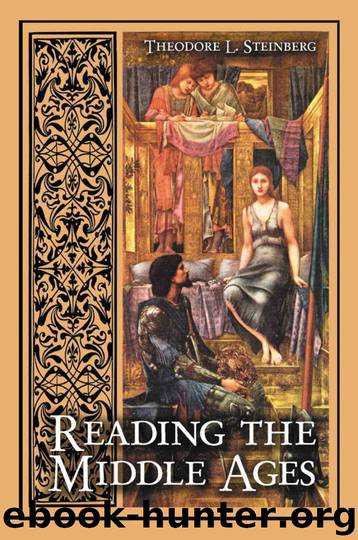Reading the Middle Ages: An Introduction to Medieval Literature by Steinberg Theodore L

Author:Steinberg, Theodore L. [Steinberg, Theodore L.]
Language: eng
Format: azw3
Publisher: McFarland & Company
Published: 2003-05-28T16:00:00+00:00
VI. Jewish Literature
THE JEWS IN CHRISTIAN EUROPE
The Tale of Genji took us outside of the world of Western European Christendom, but even within, that world was not quite so homogeneous as we sometimes imagine. There were, of course, major national and regional distinctions, even though medieval culture was in many ways international. For example, beginning in the twelfth century, the Gothic style of architecture swept across much of Europe, but English Gothic differs from French Gothic which differs from Gothic in other places. At the same time, despite these national differences, Gothic is always recognizable as Gothic.
There was, however, one major minority group in Europe during the Middle Ages whose cultural achievements are often overlooked in studies of medieval literature, the Jews. Today, many people take for granted the value of multiculturalism and diversity. We regard tolerance of differences as a bare minimum for the functioning of society, but we also encourage the understanding and appreciation of cultures and traditions different from our own. Though such views are common in our society, they are certainly not universal. In the Middle Ages, they were nearly non-existent. Whatever virtues existed in the Middle Ages, tolerance was not among them.
We can use Islam as an example. Until the beginning of the Crusades (in the very late eleventh century), most people in Europe knew nothing of Islamic culture, which in many respects was greatly superior to European culture. Nevertheless, Moslems were regarded with some horror and were subject to slaughter by the Crusaders. Even in Dante, Islam is treated as a Christian heresy; well into the Renaissance, literary works are filled with enemy “infidels” and “Saracens.” Very few Europeans made any effort to understand or appreciate Islam, even though many European thinkers, like Thomas Aquinas, were influenced by Moslem thought.
The same kind of thinking affected medieval attitudes toward Jews, who, unlike Moslems, actually lived in Europe. Jews believe in the Old Testament but not in the New Testament,1 which means that they do not believe that Jesus was either the Messiah or the Son of God. For medieval Jews, these beliefs clearly set them apart from the Christian majority, as did their adherence to the biblical dietary laws, the strict observance of Sabbath laws on Saturdays, the celebration of Jewish holidays, and other traditions that Christians regarded as no longer necessary after the Crucifixion. But the most serious liability that afflicted the Jews was the false accusation that they had been responsible for the Crucifixion, that they were “Christ-killers.” Modern historians understand that this charge totally lacks foundation, but in the Middle Ages, it was an article of faith. One result was that attacks against the Jews often increased around the time of Easter. And later on that accusation contributed to another, the Blood Libel, which stated that Jews used the blood of Christian children in the production of Passover matzah.
In fact, an overview of Jewish history in medieval Europe looks like an unmitigated series of horrors. At the time of the Black Death, for example, Jews were accused of causing the plague by poisoning the wells.
Download
This site does not store any files on its server. We only index and link to content provided by other sites. Please contact the content providers to delete copyright contents if any and email us, we'll remove relevant links or contents immediately.
4 3 2 1: A Novel by Paul Auster(11818)
The handmaid's tale by Margaret Atwood(7469)
Giovanni's Room by James Baldwin(6826)
Asking the Right Questions: A Guide to Critical Thinking by M. Neil Browne & Stuart M. Keeley(5366)
Big Magic: Creative Living Beyond Fear by Elizabeth Gilbert(5362)
Ego Is the Enemy by Ryan Holiday(4967)
On Writing A Memoir of the Craft by Stephen King(4673)
The Body: A Guide for Occupants by Bill Bryson(4596)
Ken Follett - World without end by Ken Follett(4452)
Bluets by Maggie Nelson(4280)
Adulting by Kelly Williams Brown(4243)
Eat That Frog! by Brian Tracy(4167)
Guilty Pleasures by Laurell K Hamilton(4127)
White Noise - A Novel by Don DeLillo(3838)
The Poetry of Pablo Neruda by Pablo Neruda(3825)
Fingerprints of the Gods by Graham Hancock(3746)
Alive: The Story of the Andes Survivors by Piers Paul Read(3743)
The Book of Joy by Dalai Lama(3710)
The Bookshop by Penelope Fitzgerald(3626)
